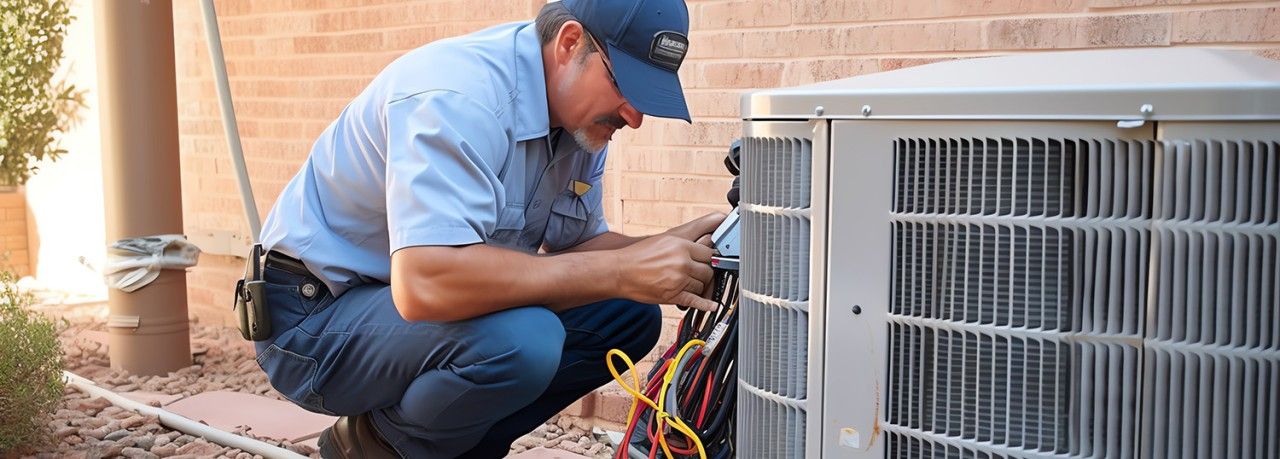Everything You Should Know About Residential Heating and Cooling
There are different types of residential HVAC systems that can keep you cool during the hottest summer months.
Hvac Split System
An HVAC split system refers to a type of heating, ventilation, and air conditioning (HVAC) system commonly used in residential and small commercial buildings. It consists of two main components: an indoor unit and an outdoor unit.
Indoor Unit: This component typically contains the evaporator coil responsible for cooling the air and a fan to circulate the conditioned air throughout the building. In heating mode, it may also contain a heat exchanger or electric heating elements.
Outdoor Unit: Also known as the condensing unit, this part of the system houses the compressor, condenser coil, and a fan. It's responsible for releasing heat absorbed from indoor air during the cooling process to the outdoor environment.
The two units are connected by refrigerant lines, which circulate refrigerant between them. During operation, the indoor unit absorbs heat from indoor air, cooling it down, while the outdoor unit releases this absorbed heat to the outside environment. In heating mode, the process is reversed, with the outdoor unit absorbing heat from the outdoor air and transferring it indoors.
Split systems are popular because they offer flexibility in installation, are relatively easy to maintain, and provide efficient heating and cooling. They're often used in conjunction with ductwork to distribute conditioned air throughout the building.
Hybrid Heat Pump HVAC System
A hybrid heat pump HVAC system combines the functionality of a traditional heat pump with a backup heating source, usually a gas furnace. This combination allows the system to efficiently heat and cool a building in a variety of conditions, maximizing energy efficiency and comfort.
Here's how it typically works:
Heat Pump Functionality: Like a standard heat pump, the system uses refrigerant to transfer heat between the indoors and outdoors. In heating mode, it extracts heat from the outdoor air (even in cold temperatures) and transfers it indoors to warm the building. In cooling mode, it removes heat from indoor air and releases it outside.
Backup Heating: When outdoor temperatures drop too low for the heat pump to operate efficiently, or when there's a high demand for heating, the system switches to the backup heating source, usually a gas furnace. The furnace provides supplemental heat to maintain comfortable indoor temperatures.
Automatic Switching: A control system manages the switching between the heat pump and the furnace based on factors such as outdoor temperature, indoor temperature demand, and energy efficiency considerations. This ensures that the system operates as efficiently as possible while maintaining comfort.
Hybrid heat pump systems offer several advantages:
Energy Efficiency: They can achieve higher energy efficiency compared to traditional heating systems, especially in moderate climates where the heat pump can handle most of the heating load.
Comfort: The backup heating source ensures that the system can effectively heat the building even in extremely cold conditions.
Flexibility: Users can choose between the more efficient heat pump operation or the faster heating provided by the furnace based on their preferences and energy costs.
Reduced Environmental Impact: By utilizing a heat pump, which operates on electricity and can be powered by renewable energy sources, along with a gas furnace as backup, hybrid systems can reduce greenhouse gas emissions compared to systems that rely solely on fossil fuels for heating.
Overall, hybrid heat pump HVAC systems offer a balanced approach to heating and cooling, providing both efficiency and reliability across a range of weather conditions.
Duct-Free Mini Split System
A duct-free mini-split HVAC system, also known as a ductless mini-split system, is a type of heating, ventilation, and air conditioning (HVAC) system that does not require ductwork to distribute conditioned air throughout a building. Instead, it consists of one or more indoor units mounted on walls or ceilings in individual rooms or zones, and an outdoor unit connected by refrigerant lines.
Here's how it typically works:
ndoor Units: Each indoor unit contains an evaporator coil, a fan, and a filter. These units are installed in the rooms or zones that require heating or cooling. They are typically mounted high on a wall or suspended from the ceiling to distribute air evenly throughout the space.
Outdoor Unit: The outdoor unit houses the compressor, condenser coil, and fan. It is installed outside the building and is connected to the indoor units by refrigerant lines and electrical wiring.
Refrigerant Lines: Refrigerant lines run between the indoor and outdoor units, circulating refrigerant to transfer heat between the indoor and outdoor environments. These lines are usually routed through small holes in the wall or ceiling, requiring minimal disruption to the building's structure.
Control System: A control system allows users to set the desired temperature for each indoor unit independently. Some systems also offer features such as programmable schedules, remote control, and zoning capabilities, allowing for greater customization and energy efficiency.
Ductless mini-split systems offer several advantages:
Flexibility: Because they do not require ductwork, ductless systems are ideal for retrofitting older buildings or for use in spaces where ductwork is impractical or impossible to install.
Zoning: Each indoor unit can be controlled independently, allowing users to set different temperatures for each room or zone. This can lead to energy savings by only heating or cooling occupied areas.
Energy Efficiency: Ductless systems are highly efficient because they eliminate the energy losses associated with ductwork, which can account for up to 30% of energy consumption in traditional ducted systems.
Improved Indoor Air Quality: With individual air handlers in each room, ductless systems can help improve indoor air quality by filtering out dust, allergens, and other particles.
Overall, ductless mini-split HVAC systems offer a versatile and energy-efficient solution for heating and cooling individual rooms or zones within a building, providing comfort and control while minimizing installation and operating costs.
Beyond residential heating and cooling, different features of an HVAC system can impact your energy costs, efficiency and comfort of your home.
Energy efficiency: Energy-efficient types of residential HVAC equipment are good for the environment and provide significant savings on your utility bills. To learn more about what these energy ratings mean, click here.
Indoor air quality: Your HVAC system is responsible for regulating and circulating airflow around your home, so improving indoor air quality can improve the comfort and health of your home. Indoor air quality products, such as ventilators, humidifiers, dehumidifiers and air cleaners, can be helpful in homes with pets or those with allergies, asthma or concerns related to airborne viruses, bacteria or mold.
Thermostats: Your thermostat is the command center of your HVAC system. In addition to controlling indoor temperature, thermostats can integrate smart home features while improving efficiency and reducing energy costs. Some YORK® thermostats integrate voice control using Amazon Alexa, remote access and monitoring via a smart device (including Apple Watch®), and include service alerts and remote dealer monitoring.
The team at Blizzard Conditions are your Certified Comfort Experts for YORK HVAC Systems. Call us today, and we’ll help you find the perfect system for your home!
When you subscribe to the blog, we will send you an e-mail when there are new updates on the site so you wouldn't miss them.







Comments